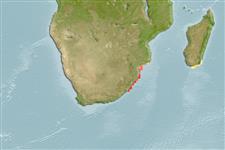Classificação / Names
Nomes comuns | Sinônimos | Catalog of Fishes(Gênero, Espécies) | ITIS | CoL | WoRMS | Cloffa
>
Eupercaria/misc (Various families in series Eupercaria) >
Labridae (Wrasses) > Corinae
Etymology: Halichoeres: Greek, als, alis = salt + Greek, choiros = pig (Ref. 45335); zulu: Named for the indigenous people of the Province of Kwazulu-Natal, South Africa..
More on authors: Randall & King.
Environment: milieu / climate zone / depth range / distribution range
Ecologia
marinhas associadas(os) a recifes; intervalo de profundidade 0 - 2 m (Ref. 83900). Subtropical
Western Indian Ocean: South Africa.
Tamanho / Peso / Idade
Maturity: Lm ? range ? - ? cm
Max length : 13.5 cm SL macho/indeterminado; (Ref. 83900); 7.9 cm SL (female)
Descrição suscinta
Chaves de identificação | Morfologia | Morfometria
Espinhos dorsais (total) : 9; Raios dorsais (total) : 11; Espinhos anais: 3; Raios anais : 11. This species is characterized by the following: D IX,11; A III,11; pectoral rays 14 (rarely 13); 26 lateral line scales; naked head with no small scales on opercle or behind eye; narrow median dorsal zone of nape naked; 7 prepelvic scales, anterior third of chest naked; 3-5 tubule branches on lateral line scales; 11-15 suborbital pores; 19-21 gill rakers; body depth 2.95-3.6 in SL; caudal fin slightly rounded, 1.4-1.45 in HL; preserved color of female pale tan, the scales on upper two-thirds of body, posterior to pectoral fins, with brown centers, those below soft portion of dorsal fin and in lowermost row dark brown; 3 broad dusky bars on chest and abdomen, fading ventrally; opercular flap at upper end of gill opening with a black spot shaped like an inverted comma; usually present behind upper part of orbit is a dark brown spot of near-pupil size; snout with an oblique dusky band; across cheek and opercle is an elongated, dark-edged, horseshoe-shaped band; oblique brown bands on dorsal fin with a small black spot on first membrane and an ocellated black spot between second and fourth dorsal soft rays; small dark spots on caudal fin rays; similar basic color pattern in male, but most markings are darker; no black spot anteriorly on dorsal fin and no oblique bands in spinous portion; base of anal fin with a wavy dark band and a pale spot at base of each membrane. In life, females are mainly pink or lavender-pink, with narrow pale green bands, a bright red stripe on nape, extending below base of spinous portion of dorsal fin, a row of small dark brown spots on side of body above anal fin; males with deep pink and bright green bands on head, with alternating wavy stripes of bright green and purplish red on body (Ref. 83900).
A rare species with paucity of specimens, this is partly due to its misidentification as Halichoeres nebulosus, its usual shallow-water habitat off exposed rocky shores where it is difficult to collect and its being very elusive. Found on rocky bottom or sand with scattered patches of reef at depths of 0.5-1.5 meters. A male individual was photographed from a pool (about 5 m long, 2 m wide and 1.2 m deep) almost close to the sea at low tide (Ref. 83900).
Ciclo de vida ou comportamento de acasalamento
Maturities | Reprodução | Spawnings | Egg(s) | Fecundities | Larvas
Distinct pairing during breeding (Ref. 205).
Randall, J.E. and D.R. King, 2010. Halichoeres zulu, a new labrid fish from South Africa. Smithiana Bull. 11:17-23. (Ref. 83900)
Status na Lista Vermelha da UICN (Ref. 130435)
Ameaça para os humanos
Harmless
Uso pelos humanos
Ferramentas
Relatórios especiais
Baixar XML
Fontes da internet
Estimates based on models
Preferred temperature (Ref.
123201): 23.6 - 25.4, mean 24.9 °C (based on 27 cells).
Índice de diversidade filogenética (Ref.
82804): PD
50 = 0.5000 [Uniqueness, from 0.5 = low to 2.0 = high].
Bayesian length-weight: a=0.00955 (0.00451 - 0.02020), b=3.09 (2.92 - 3.26), in cm total length, based on LWR estimates for this Genus-body shape (Ref.
93245).
Nível Trófico (Ref.
69278): 3.5 ±0.5 se; based on size and trophs of closest relatives
Resiliência (Ref.
120179): Elevada, tempo mínimo de duplicação da população menor que 15 meses (Preliminary K or Fecundity.).
Fishing Vulnerability (Ref.
59153): Low vulnerability (10 of 100).
